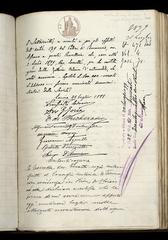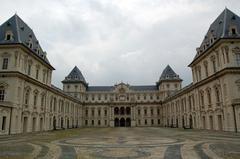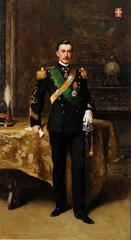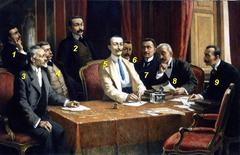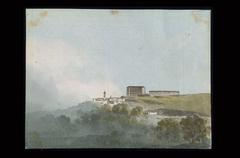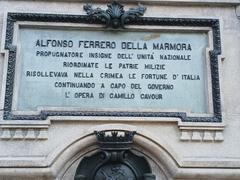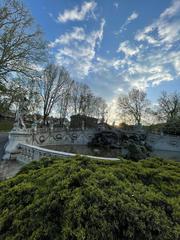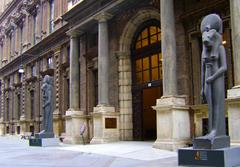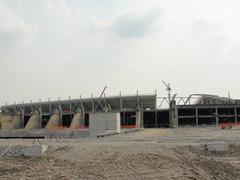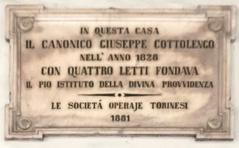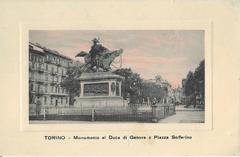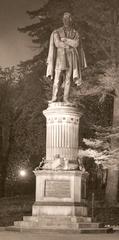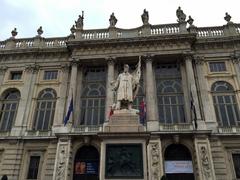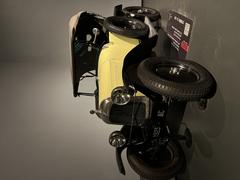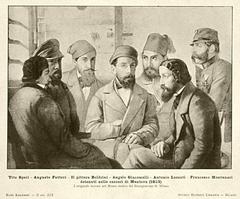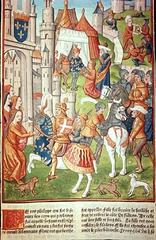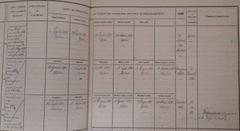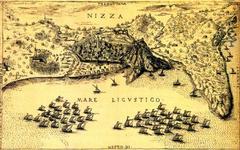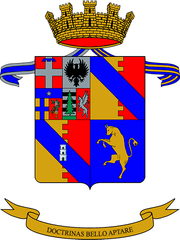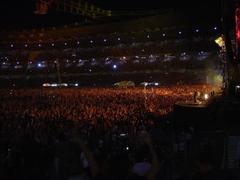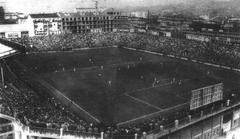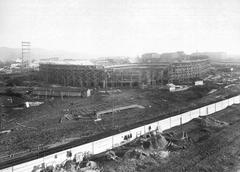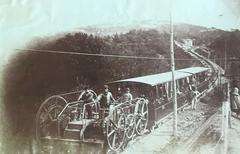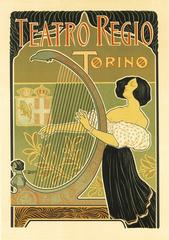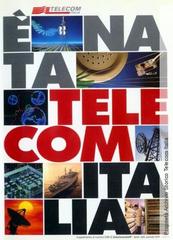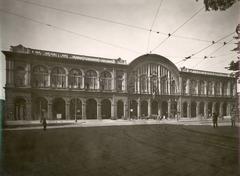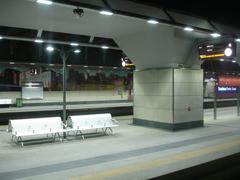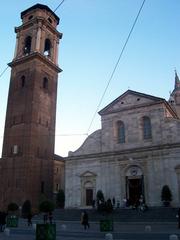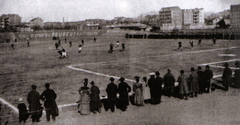
Piazza Statuto Turin: Visiting Hours, Tickets, and Historical Sites Guide
Date: 04/07/2025
Introduction: Piazza Statuto’s Significance in Turin
Piazza Statuto is one of Turin’s most emblematic squares, fusing 19th-century urban development with profound political, cultural, and esoteric significance. Conceived during the period of Italian unification, it not only boasts elegant neoclassical architecture and monumental porticoes but also serves as a symbolic gateway between Turin’s historic core and its western districts (MuseoTorino). At its heart stands the Monument to the Frejus Tunnel, commemorating the engineering marvel that linked Italy and France through the Alps, and fueling the square’s legendary status in Turin’s esoteric traditions (La Voce Torino; Sightseeing Experience). Visitors can delve into layers of history—from its political symbolism and role in social movements to its architectural harmony and aura of mystery—making Piazza Statuto a must-see for history lovers, architecture enthusiasts, and seekers of Turin’s magical reputation.
Table of Contents
- Introduction
- Origins and Urban Planning
- Architectural Features and Urban Integration
- Political and Social Milestones
- Monumental Landmarks and Esoteric Associations
- Visiting Hours, Tickets, and Accessibility
- Nearby Attractions and Travel Tips
- Visuals and Media
- Frequently Asked Questions (FAQ)
- Sources and Further Reading
- Conclusion and Recommendations
Origins and Urban Planning
Piazza Statuto’s creation reflects the transformation of Turin during the 19th century. Originally planned in 1846 but delayed by military constraints, the square’s development accelerated after the Kingdom of Italy was proclaimed in 1861. King Vittorio Emanuele II authorized the city’s expansion westward, and Piazza Statuto was formalized as a key element in the urban plan. Construction began in 1864 under architect Giuseppe Bollati and was completed in 1865, funded by international capital (MuseoTorino).
Architectural Features and Urban Integration
The square is defined by its elongated, nearly rectangular shape, lined with harmonious neoclassical buildings and continuous porticoes. These structures, designed for both residential and commercial use, feature rational layouts, decorative entrance halls, and stately facades, echoing the grandeur of other famous Turin squares like Piazza Castello and Piazza San Carlo (MuseoTorino). Piazza Statuto’s strategic location connects major thoroughfares such as Via Garibaldi, Corso Francia, and Via San Donato, bridging the city’s historic center with its expanding west.
Political and Social Milestones
Named after the Statuto Albertino—the constitutional charter granted by King Carlo Alberto in 1848—Piazza Statuto is steeped in political symbolism (Wikipedia). The square has hosted significant public demonstrations, including the 1864 riots following the transfer of Italy’s capital from Turin to Florence and the pivotal 1962 labor protests by Fiat and Lancia workers. These episodes cemented its reputation as a central stage for civic life and social change in Turin (Wikipedia).
Monumental Landmarks and Esoteric Associations
Monument to the Frejus Tunnel
The centerpiece of Piazza Statuto is the Monument to the Frejus Tunnel, unveiled in 1879. Designed by Luigi Belli and Odoardo Tabacchi, this dramatic stone pyramid honors the workers who perished constructing the tunnel beneath the Alps. It features allegorical Titans, a winged angel (often interpreted as the “Genius of Science” or, in local legend, as Lucifer), and a five-pointed star—details that reinforce both its triumphal and mystical aura (La Voce Torino; Veronika’s Adventure).
Esoteric and Cultural Symbolism
Piazza Statuto is renowned as one of the vertices of the “black magic triangle” (with London and San Francisco), stemming from its history as a Roman burial and execution ground and its westward orientation (Sightseeing Experience; Musement Blog). Local legends claim that the monument marks the “Gate of Hell,” while hidden Masonic and occult symbols are said to abound in the square’s architecture (Angoli Torino). Guided esoteric tours often highlight these mysterious aspects.
Other Architectural Highlights
Piazza Statuto is encircled by elegant porticoed buildings that house shops, cafes, and offices. Noteworthy structures include the Palace of Justice—an imposing neoclassical edifice—and the former Fiat headquarters, reflecting both the city’s judicial and industrial legacy (Veronika’s Adventure).
Visiting Hours, Tickets, and Accessibility
- Visiting Hours: Piazza Statuto is a public square open 24/7. Monuments and porticoes are accessible day and night, though daylight is recommended for sightseeing.
- Tickets: Entry is free. Guided tours exploring the square’s history and esoteric symbolism are available for a fee (typically €15–€25), bookable online or at tourist offices.
- Accessibility: The square is wheelchair friendly with flat, paved surfaces and ramps. Public transportation links are excellent, with Porta Susa train station and “XVIII Dicembre” metro stop nearby (ibnbattutatravel.com).
Nearby Attractions and Travel Tips
- Via Garibaldi: A major pedestrian street lined with shops and historic buildings.
- Porta Susa Station: Turin’s main railway hub, less than 10 minutes’ walk from the square.
- Quadrilatero Romano: The vibrant Roman quarter, known for restaurants and nightlife (we3travel.com).
- Piazza Castello: The city’s historic heart, a 15-minute walk away.
- Porta Palazzo Market: Europe’s largest open-air market, a must-visit for foodies.
- Tips: Wear comfortable shoes for exploring cobbled streets and porticoes. Spring and autumn offer the best weather for walking tours.
Visuals and Media Suggestions
- [Insert high-quality image of Piazza Statuto: “Piazza Statuto Turin historical square with neoclassical buildings”]
- [Insert image of the Frejus Tunnel Monument: “Monument to the Frejus Tunnel in Piazza Statuto, Turin”]
- [Embed interactive map pinpointing Piazza Statuto and nearby attractions]
- [Optional: Link to a virtual or video tour highlighting architectural and esoteric features]
Frequently Asked Questions (FAQ)
What are Piazza Statuto’s visiting hours?
The square is open to the public 24/7, year-round.
Is there an entrance fee?
No, visiting Piazza Statuto is free. Guided tours may charge a fee.
Are guided tours available?
Yes, several guided tours focus on the square’s history and esoteric legends. Booking in advance is recommended.
How can I reach Piazza Statuto?
The square is easily accessible via Porta Susa train and metro stations, as well as multiple bus and tram lines.
Is the square wheelchair accessible?
Yes, Piazza Statuto and its porticoes have flat, accessible surfaces.
What are the best times to visit?
Daytime visits allow for detailed exploration. Evening visits offer atmospheric views, especially of the illuminated monument.
Are there other attractions nearby?
Yes, including Via Garibaldi, Quadrilatero Romano, Porta Palazzo Market, and Piazza Castello.
Sources and Further Reading
- MuseoTorino - Piazza Statuto Turin: Visiting Hours, Tickets, and Historical Guide
- La Voce Torino - Piazza Statuto: Visiting Hours, Tickets & Architectural Highlights
- Angoli Torino - Piazza Statuto: Visiting Hours, Tickets, and Exploring Turin’s Most Enigmatic Historical Site
- Sightseeing Experience - Piazza Statuto: Visiting Hours, Tickets, and Exploring Turin’s Most Enigmatic Historical Site
- guidatorino.com - Piazza Statuto Visiting Hours, Tickets, and Travel Guide to Turin’s Historic Square
- Musement Blog - Esoteric Turin: A Journey Between White and Black Magic
- ibnbattutatravel.com - Piazza Statuto Turin
- we3travel.com - Must-See Spots in Turin
- thetravelfolk.com - Is Turin Worth Visiting?
- Veronika’s Adventure - Magic Turin Tour
Conclusion and Recommendations
Piazza Statuto stands as a compelling blend of neoclassical splendor, political history, and esoteric legend. Its open, accessible design and central location make it a prime destination for tourists and locals alike. Visitors can admire its monumental architecture, reflect on its role in shaping modern Italy, and immerse themselves in Turin’s magical traditions—whether through self-guided exploration or with the help of expert-led tours.
Visitor Recommendations:
- Allow time to explore both the square and its surrounding neighborhoods.
- Join a guided esoteric or historical tour for deeper insights.
- Visit during spring or autumn for the most pleasant experience.
- Use public transport for easy access and to avoid central parking challenges.
- Download the Audiala app for curated guides, interactive maps, and the latest updates on Turin’s historical sites.
Piazza Statuto invites you to discover its stories—where the past meets the mystical in the heart of Turin.



